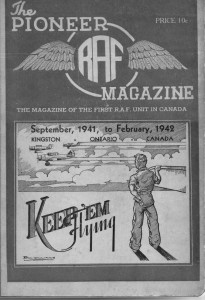No. 31 S.F.T.S. was the first R.A.F. school to be transferred to Canada, thus the name they assigned to themselves, ‘The Pioneers’. It earned another place in history by being the first school in Canada to train Fleet Air Arm pilots. The first group of thirty-three trainees arrived on December 30, 1940 from 24 E.F.T.S., Luton, England. Also arriving at the same time were six R.A.F. pupils from 2 E.F.T.S. in Staverton. These were men who had completed their elementary flying training, which was done in biplane aircraft.
Among the pilot trainees were officers who had served in the Navy prior to transferring to the Fleet Air Arm and the initials after their name show whether or not they were regulars or reserve. Many Canadian officers transferred to the Royal Navy Fleet Air Arm before an air arm of the Royal Canadian Navy was established.
An ex-F.A.A., Peter Roome, writing from his home in Wales, related an oft-repeated saying: “We used to have a bit of a joke with the permanent commissioned Royal Navy officers who thought they were much more superior than the average pilot type who didn’t know much about seamanship. Most pilots were Royal Navy Volunteer Reserve, and most were fairly well educated and middle class. Some were R.N.R. and they had done some service in the merchant navy. So we used to say, ‘What’s the difference between the R.N.V.R., R.N.R., and R.N.?’ The answer being, ‘R.N.V.R. are gentlemen trying to be sailors, R.N.R. are sailors trying to be gentlemen, and R.N. are neither trying to be both’.”
A large number of F.A.A. pilot trainees were sent to Canada for their elementary training and then were posted to No. 31 for service flying training in junior, intermediate and advance school. Fleet Air Arm also trained at stations in the United States. Beginning with the first class in August of 1943, F.A.A. pupils also received pilot training in Canada at No. 14 S.F.T.S. in Aylmer, Ontario, until that school was transferred to Kingston in 1944. (In at least one history, that station has been misidentified as being in Quebec.)

The airmen began publishing a station magazine for the first two years. Supposedly, local publications objected to the competition for local advertising and it was shut down after the first echelon returned to the U.K. I’m grateful to John Rayner for the loan of his copies, and to John Kendall and Jim Gillespie.